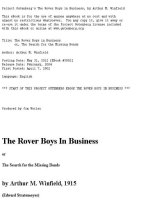Project Gutenberg''''s The Life-Story of Insects, by Geo. H. Carpenter pot
Bạn đang xem bản rút gọn của tài liệu. Xem và tải ngay bản đầy đủ của tài liệu tại đây (2.45 MB, 370 trang )
Project Gutenberg's The Life-Story of
Insects, by Geo. H. Carpenter
This eBook is for the use of anyone
anywhere at no cost and with
almost no restrictions whatsoever. You may
copy it, give it away or
re-use it under the terms of the Project
Gutenberg License included
with this eBook or online at
www.gutenberg.net
Title: The Life-Story of Insects
Author: Geo. H. Carpenter
Release Date: August 1, 2005 [EBook
#16410]
Language: English
*** START OF THIS PROJECT GUTENBERG EBOOK
THE LIFE-STORY OF INSECTS ***
Produced by Justin Kerk, Laura Wisewell
and the Online
Distributed Proofreading Team at
The Cambridge Manuals of Science and
Literature
THE LIFE-
STORY OF
INSECTS
CAMBRIDGE UNIVERSITY PRESS
London: FETTER LANE, E.C.
C. F. CLAY, Manager
Edinburgh: 100, PRINCES STREET
London: H. K. LEWIS, 136, GOWER
STREET, W.C.
WILLIAM WESLEY & SON, 28, ESSEX
STREET, STRAND
Berlin: A. ASHER AND CO.
Leipzig: F. A. BROCKHAUS
New York: G. P. PUTNAM'S SONS
Bombay and Calcutta: MACMILLAN
AND CO., Ltd.
(Culex). Magnified 5 times.
A. Larva. (The head is directed
downwards and the tail-siphon
with spiracle points upwards to the
surface of the water.)
B. Pupal Cuticle from which the
Imago is emerging. (The pair of
'respiratory trumpets' on the
thorax of the pupa are
conspicuous. The wings of the
Imago are crumpled, and the hind
feet are not yet withdrawn.)
C. Adult Gnat. Female.
PRINTED BY JOHN CLAY, M.A.
AT THE UNIVERSITY PRESS
With the exception of the coat of
arms at the foot, the design on the title
page is a reproduction of one used by the
earliest known Cambridge printer John
Siberch 1521
The object of this little book is to afford
an outline sketch of the facts and meaning
of insect-transformations. Considerations
of space forbid anything like an exhaustive
treatment of so vast a subject, and some
aspects of the question, the physiological
for example, are almost neglected. Other
books already published in this series,
such as Dr Gordon Hewitt's House-flies
and Mr O H. Latter's Bees and Wasps,
may be consulted with advantage for
details of special insect life-stories.
Recent researches have emphasised the
PREFACE
practical importance to human society of
entomological study, and insects will
always be a source of delight to the lover
of nature. This humble volume will best
serve its object if its reading should lead
fresh observers to the brookside and the
woodland.
G. H. C.
Dublin,
July, 1913.
CONTENTS
Chap. Page.
I. Introduction
II. Growth and Change
III. The Life-stories of some
Sucking Insects
IV. From Water to Air
V. Transformations, Outward
and Inward
VI. Larvae and their Adaptations
VII. Pupae and their
Modifications
VIII. The Life-story and the
Seasons
1
8
16
23
35
49
79
89
IX. Past and Present—the
Meaning of the Story
Outline Classification of
Insects
Table of Geological Systems
Bibliography
Index
105
122
123
124
129
LIST OF
ILLUSTRATIONS
Stages in the
Transformations of a Gnat
Frontispiece
Fig. Page.
1. Stages of the Diamond-back
Moth (Plutella
cruciferarum)
2. Head of typical Moth
3. Head of Caterpillar
4. Common Cockroach (Blatta
orientalis)
5. Nymph of Locust
3
5
5
12
(Schistocera americana)
6. Aphis pomi, winged and
wingless females
7. Mussel Scale-Insect
(Mytilaspis pomorum)
8. Emergence of Dragon-fly
(Aeschna cyanea)
9. Nymph of May-fly (Chloeon
dipterum)
10. Imaginal buds of Butterfly
11. Imaginal buds of Blow-fly
12. Carrion Beetle (Silpha) and
larva
13. Larva of Ground-beetle
(Aepus)
14. Willow-beetle
(Phyllodecta) and larva
13
19
21
29-31
33
39
43
51
52
53
15. Cabbage-beetle (Psylliodes)
and larva
16. Corn Weevil (Calandra)
and larva
17. Ruby Tiger Moth
(Phragmatobia fuliginosa)
18. Larvae and Pupa of Hive-
bee (Apis mellifica)
19. Larva of Gall-midge
(Contarinia nasturtii)
20. Crane-fly (Tipula oleracea)
and larva
21. Maggot of House-fly (Musca
domestica)
22. Ox Warble-fly (Hypoderma
bovis) with egg, larva, and
puparium
54
55
61
65
68
69
71
75
23. Pupa of White Butterfly
(Pieris)
85
Among the manifold operations of living
creatures few have more strongly
impressed the casual observer or more
deeply interested the thoughtful student
than the transformations of insects. The
schoolboy watches the tiny green
caterpillars hatched from eggs laid on a
cabbage leaf by the common white
butterfly, or maybe rears successfully a
batch of silkworms through the changes
and chances of their lives, while the
CHAPTER I
INTRODUCTION
naturalist questions yet again the 'how' and
'why' of these common though wondrous
life-stories, as he seeks to trace their
course more fully than his predecessors
knew.
cruciferarum) ; b, young caterpillar,
dorsal view; c, full-grown caterpillar,
dorsal view; d, side view; e, pupa, ventral
view. Magnified 6 times. From Journ.
Dept. Agric. Ireland, vol. I.
Everyone is familiar with the main
facts of such a life-story as that of a moth
or butterfly. The form of the adult insect
(fig. 1 a) is dominated by the wings—two
pairs of scaly wings, carried respectively
on the middle and hindmost of the three
segments that make up the thorax or
central region of the insect's body. Each of
these three segments carries a pair of legs.
In front of the thorax is the head on which
the pair of long jointed feelers and the
p a i r of large, sub-globular, compound
eyes are the most prominent features.
Below the head, however, may be seen,
now coiled up like a watch-spring, now
stretched out to draw the nectar from some
scented blossom, the butterfly's sucking
trunk or proboscis, situated between a
pair of short hairy limbs or palps (fig. 2).
These palps belong to the appendages of
the hindmost segment of the head,
appendages which in insects are modified
to form a hind-lip or labium, bounding the
mouth cavity below or behind. The
proboscis is made up of the pair of jaw-
appendages in front of the labium, the
maxillae, as they are called. Behind the
thorax is situated the abdomen, made up
of nine or ten recognisable segments, none
of which carry limbs comparable to the
walking legs, or to the jaws which are the
modified limbs of the head-segments. The
whole cuticle or outer covering of the
body, formed (as is usual in the group of
animals to which insects belong) of a
horny (chitinous) secretion of the skin, is
firm and hard, and densely covered with
hairy or scaly outgrowths. Along the sides
of the insect are a series of paired
openings or spiracles, leading to a set of
air-tubes which ramify throughout the
body and carry oxygen directly to the
tissues.
Fig. 2. A. Head of a typical Moth, showing
proboscis formed by flexible maxillae (g)
between the labial palps (p); c, face; e,
eye; the structure m has been regarded
as the vestige of a mandible. B. Basal
part (b) of maxilla removed from head,
with vestigial palp (p). Magnified.
Such a butterfly as we have briefly
sketched lays an egg on the leaf of some
suitable food-plant, and there is hatched
from it the well-known crawling larva
[1]
(fig. 1 b, c, d) called a caterpillar,
offering in many superficial features a
marked contrast to its parent. Except on
the head, whose surface is hard and firm,
the caterpillar's cuticle is as a rule thin
and flexible, though it may carry a
protective armature of closely set hairs, or









